Influence of Graphene and Graphene Oxide on Properties of Spark Plasma Sintered Si3N4 Ceramic Matrix
Abstract
1. Introduction
2. Experimental Part
2.1. Preparation of Multilayered Graphene
2.2. Preparation of Graphene Oxide
2.3. Preparation of Composites
2.4. Characterization Methods
3. Results and Discussion
3.1. Mechanical Properties of Spark Plasma Sintered Si3N4-Based Composites
3.2. Structural Properties of Spark Plasma Sintered Si3N4-Based Composites
3.3. Tribological and Electrical Properties of Spark Plasma Sintered Si3N4-Based Composites
4. Conclusions
Author Contributions
Funding
Acknowledgments
Conflicts of Interest
References
- Riley, F.L. Silicon nitride and related materials. J. Am. Ceram. Soc. 2000, 83, 245–265. [Google Scholar] [CrossRef]
- Hampshire, S. Silicon nitride ceramics—Review of structure, processing and properties. J. Achiev. Mater. Manuf. Eng. 2007, 24, 43–50. [Google Scholar]
- Padture, N.P. Multifunctional Composites of Ceramics and Single-Walled Carbon Nanotubes. Adv. Mater. 2009, 21, 1767–1770. [Google Scholar] [CrossRef]
- Balazsi, C.; Konya, Z.; Weber, F.; Biro, L.P.; Arato, P. Preparation and characterization of carbon nanotube reinforced silicon nitride composites. Mater. Sci. Eng. C 2003, 23, 1133–1137. [Google Scholar] [CrossRef]
- Miranzo, P.; Ramirez, C.; Román-Manso, B.; Belmonte, M. In situ processing of electrically conducting graphene/SiC nanocomposites. J. Eur. Ceram. Soc. 2013, 33, 1665–1674. [Google Scholar] [CrossRef]
- Kun, P.; Tapaszto, O.; Weber, F.; Balázsi, C. Determination of structural and mechanical properties of multilayer graphene added silicon nitride based composites. Ceram. Int. 2012, 38, 211–216. [Google Scholar] [CrossRef]
- Lee, B.; Koo, M.Y.; Jin, H.S.; Kim, K.T.; Hong, S.H. Simultaneous strengthening and toughening of reduced graphene oxide/alumina composites fabricated by molecular-level mixing process. Carbon 2014, 78, 212–219. [Google Scholar] [CrossRef]
- Ma, B.Y.; Yu, J.K. Preparation of ZrN-Si3N4 composite powder with zircon and carbon black as raw materials. Trans. Nonferrous Met. Soc. China 2009, 19, 1222–1226. [Google Scholar] [CrossRef]
- Lee, C.; Wei, X.D.; Kysar, J.W.; Hone, J. Measurement of the elastic properties and intrinsic strength of monolayer grapheme. Science 2008, 321, 385–388. [Google Scholar] [CrossRef]
- Paci, J.T.; Belytschko, T.; Schatz, G.C. Computational studies of the structure, behavior upon heating, and mechanical properties of graphite oxide. J. Phys. Chem. 2007, C111, 18099–18111. [Google Scholar] [CrossRef]
- McAllister, M.J.; Li, J.L.; Adamson, D.H.; Schniepp, H.C.; Abdala, A.A.; Liu, J.; Herrera-Alonso, M.; Milius, D.L.; Car, R.; Pruďhomme, R.K.; et al. Single sheet functionalized graphene by oxidation and thermal expansion of graphite. Chem. Mater. 2007, 19, 4396–4404. [Google Scholar] [CrossRef]
- Morozov, S.V.; Novoselov, K.S.; Katsnelson, M.I.; Schedin, F.; Elias, D.C.; Jaszczak, J.A.; Geim, A.K. Giant Intrinsic carrier mobilities in graphene and its bilayer. Phys. Rev. Lett. 2008, 100, 6602–6607. [Google Scholar] [CrossRef] [PubMed]
- Shishir, R.S.; Chen, F.; Xia, J.; Tao, N.J.; Ferry, D.K. Room temperature carrier transport in grapheme. J. Comput. Electron. 2009, 8, 43–50. [Google Scholar] [CrossRef]
- Novoselov, K.S.; Jiang, Z.; Zhang, Y.; Morozov, S.V.; Stormer, H.L.; Zeitler, U.; Maan, J.C.; Boebinger, G.S.; Kim, P.; Geim, A.K. Room temperature quantum Hall effect in grapheme. Science 2007, 315, 1379–1383. [Google Scholar] [CrossRef] [PubMed]
- Balandin, A.A.; Ghosh, S.; Nika, D.L.; Pokatilov, E.P. Extraordinary thermal conductivity of graphene: Possible applications in thermal management. ECS Trans. 2010, 28, 63–71. [Google Scholar]
- Jiang, Z.; Zhang, Y.; Tan, Y.W.; Stormer, H.L.; Kim, P. Quantum Hall effect in grapheme. Solid State Commun. 2007, 143, 14–19. [Google Scholar] [CrossRef]
- Yang, Y.; Lin, B.; Zhang, C.; Wang, S.; Liu, K.; Yang, B. Fabrication and properties of graphene reinforced silicon nitride composite materials. Mater. Sci. Eng. A 2015, 644, 90–95. [Google Scholar] [CrossRef]
- Castro Neto, A.H.; Guinea, F.; Peres, N.M.R.; Novoselov, K.S.; Geim, A.K. The electronic properties of graphene. Rev. Mod. Phys. 2009, 81, 109–162. [Google Scholar] [CrossRef]
- Stoller, M.D.; Park, S.; Zhu, Y.; An, J.; Ruoff, R.S. Graphene-based ultracapacitors. Nano Lett. 2008, 8, 3498–3502. [Google Scholar] [CrossRef]
- Picot, O.T.; Rocha, V.R.; Ferraro, C.; Ni, N.; D’Elia, E.; Meille, S.; Chevalier, J.; Saunders, T.; Peijs, T.; Reece, M.J.; et al. Using graphene networks to build bioinspired self-monitoring ceramics. Nat. Commun. 2017, 8. [Google Scholar] [CrossRef]
- Samal, S.S.; Bal, S. Carbon Nanotube Reinforced Ceramic Matrix Composites—A Review. J. Miner. Mater. Charact. Eng. 2008, 7, 355–370. [Google Scholar] [CrossRef]
- Llorente, J.; Ramírez, C.; Belmonte, M. High graphene fillers content for improving the tribological performance of silicon nitride-based ceramics. Wear 2019, 430–431, 183–190. [Google Scholar] [CrossRef]
- Andersson, P.; Holmberg, K. Limitation on the use of Ceramics in Unlubricated Sliding Application due to Transfer Layer Formation. Wear 1994, 175, 1–8. [Google Scholar] [CrossRef]
- Hyuga, H.; Sakaguchi, S.; Hirao, K.; Yamauchi, Y.; Kanzaki, S. Influence of Microstructure and Grain Boundary Phase on Tribological Properties of Si3N4 Ceramics. Ceram. Eng. Sci. Proc. 2001, 22, 197–202. [Google Scholar]
- Kun, P.; Wéber, F.; Balázsi, C. Preparation and examination of multilayer graphene nanosheets by exfoliation of graphite in high efficient attritor mill. Centr. Eur. J. Chem. 2011, 9, 47–51. [Google Scholar] [CrossRef]
- Furko, M.; Fogarassy, Z.S.; Balázsi, K.; Balázsi, C. An economic and facile method for graphene oxide preparation from graphite powder. Resolut. Discov. 2019, 1, 5–10. [Google Scholar] [CrossRef]
- Niihara, K. Indentation Fracture Toughness of Brittle Materials for Palmqvist Cracks. In Fracture Mechanics of Ceramics; Bradt, R.C., Evans, A.G., Hasselman, D.P.H., Lange, F.F., Eds.; Plenum: New York, NY, USA, 1983; Volume 5, pp. 97–105. [Google Scholar]
- Hvizdos, P.; Puchy, V.; Duszová, A.; Dusza, J. Nanofibers, Properties and Functional Application; Tong, L., Ed.; InTechOpen Ltd.: London, UK, 2011; pp. 241–266. ISBN 978-953-307-420-7. [Google Scholar]
- Balázsi, C.; Fogarassy, Z.S.; Tapasztó, O.; Kailer, A.; Schröder, C.; Parchoviansky, M.; Galusek, D.; Dusza, J.; Balázsi, K. Si3N4/graphene nanocomposites for tribological application in aqueous environments prepared by attritor milling and hot pressing. J. Eur. Ceram. Soc. 2017, 37, 3797–3804. [Google Scholar] [CrossRef]
- Kvetková, L.; Duszová, A.; Hvizdoš, P.; Dusza, J.; Kun, P.; Balázsi, C. Fracture toughness and toughening mechanisms in graphene platelet reinforced Si3N4 composites. Scr. Mater. 2012, 66, 793–796. [Google Scholar] [CrossRef]
- Kovalčíková, A.; Balázsi, C.; Dusza, J.; Tapasztó, O. Mechanical properties and electrical conductivity in a carbon nanotube reinforced silicon nitride composite. Ceram. Int. 2012, 38, 527–533. [Google Scholar] [CrossRef]
- Sasmita, F.; Wibison, G.; Judawisastra, G.; Priambodo, T.A. Determination of elastic modulus of ceramics using ultrasonic testing. AIP Conf. Proc. 2018, 1945. [Google Scholar] [CrossRef]
- Balko, J.; Hvizdos, P.; Dusza, J.; Balázsi, C.; Gamcová, J. Wear damage of Si3N4-graphene nanocomposites at room andelevated temperatures. J. Eur. Ceram. Soc. 2014, 34, 3309–3317. [Google Scholar] [CrossRef]
- Xia, Y.F.; Zeng, Y.P.; Jiang, D.L. Dielectric and mechanical properties of porous Si3N4 ceramics prepared via low temperature sintering. Ceram. Int. 2009, 35, 1699–1703. [Google Scholar] [CrossRef]
- Rutkowski, P.; Stobierski, L.; Górny, G. Thermal stability and conductivity of hot-pressed Si3N4-graphene composites. J. Therm. Anal. Calorim. 2014, 116, 321–328. [Google Scholar] [CrossRef][Green Version]
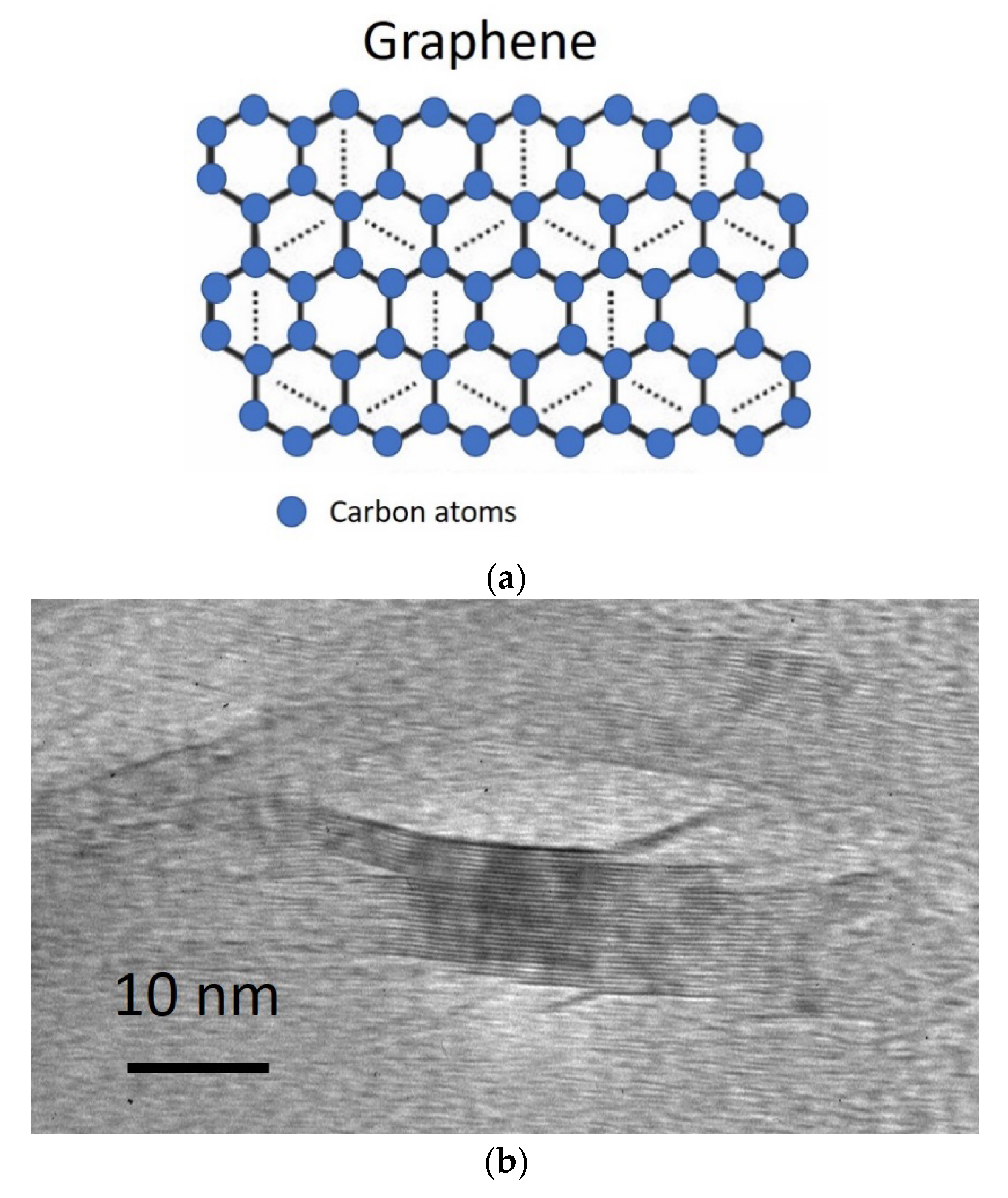
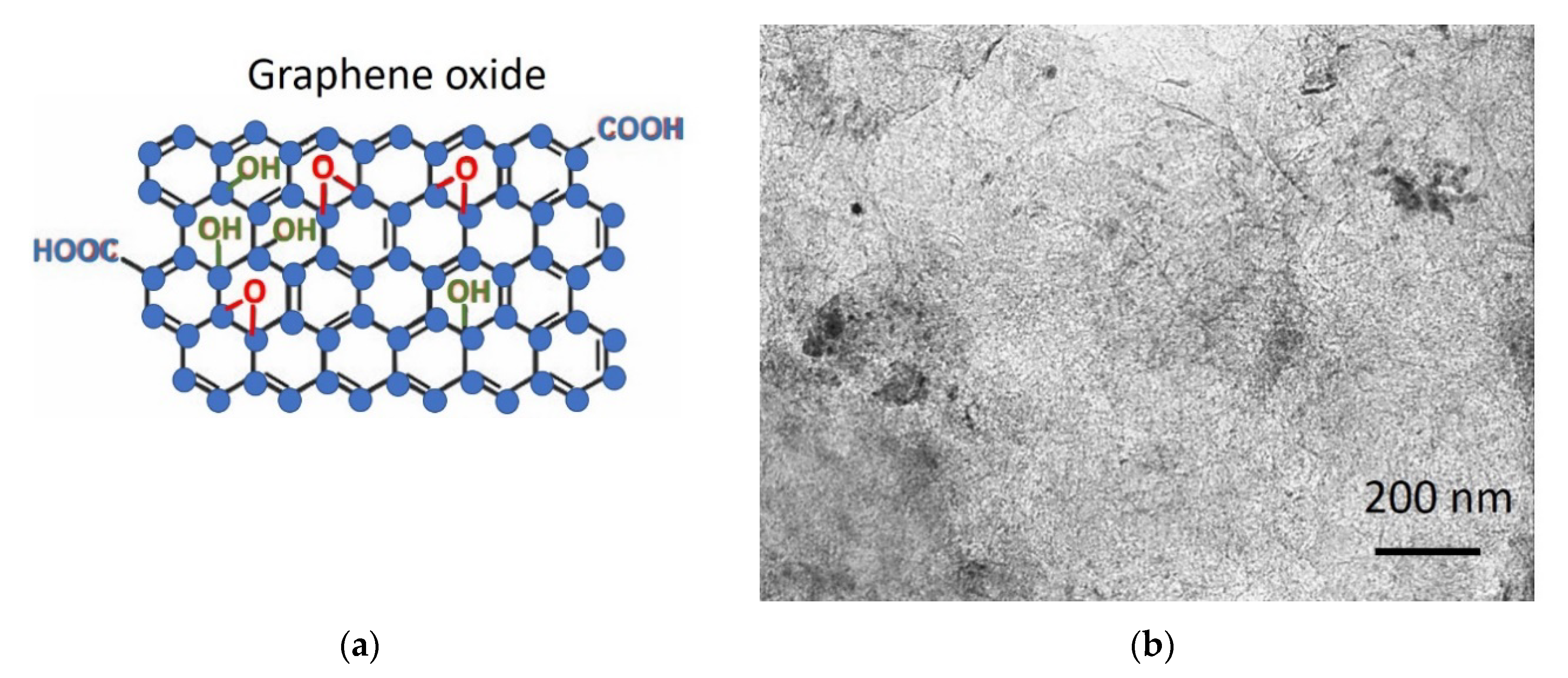
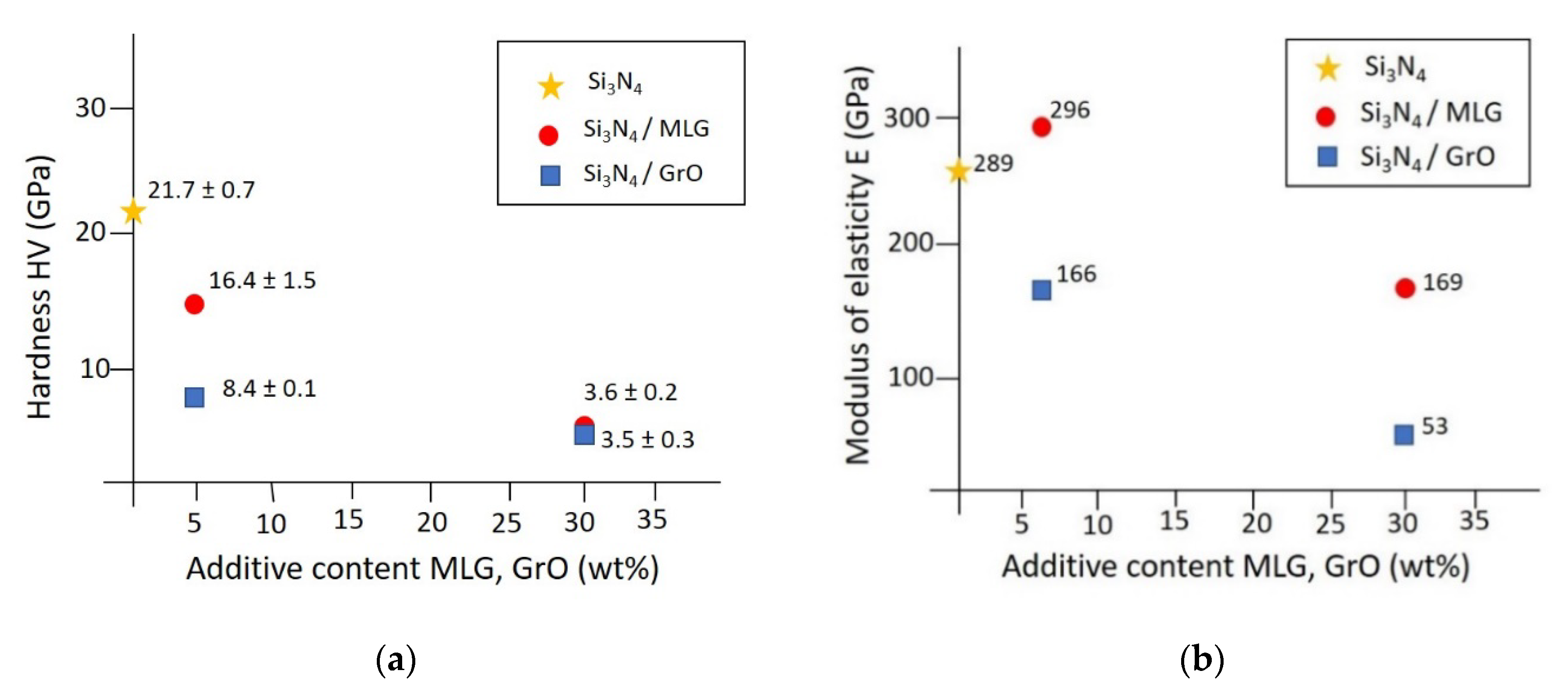
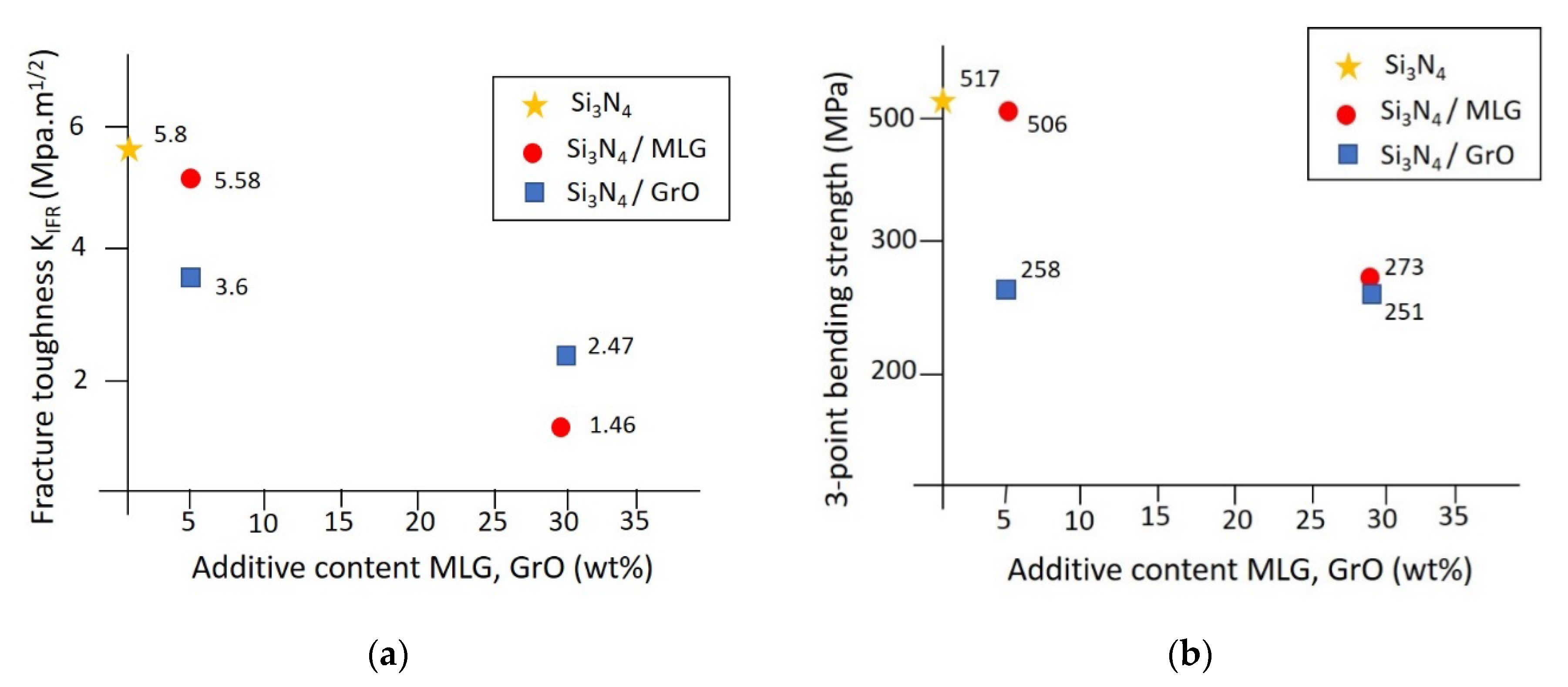
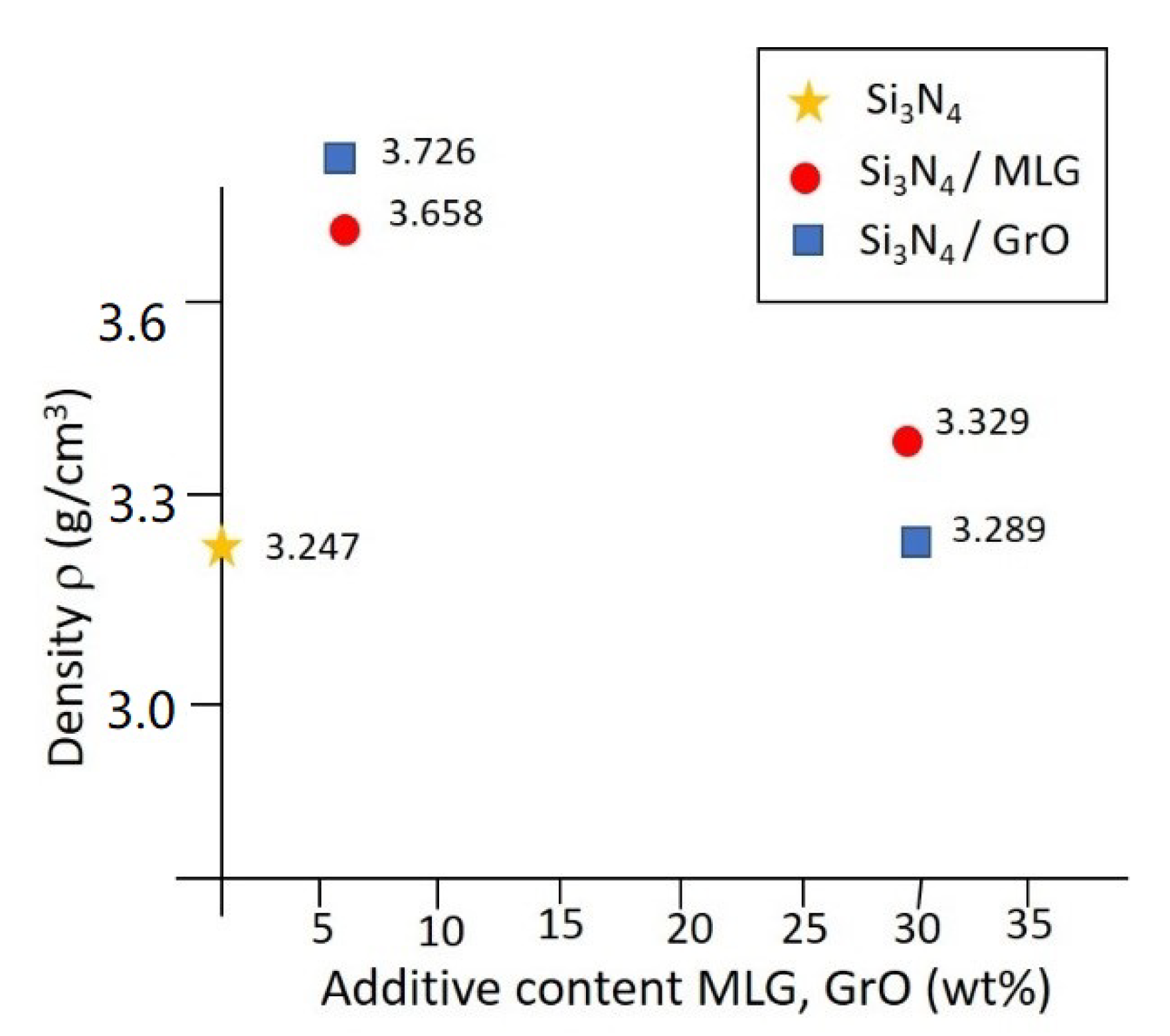

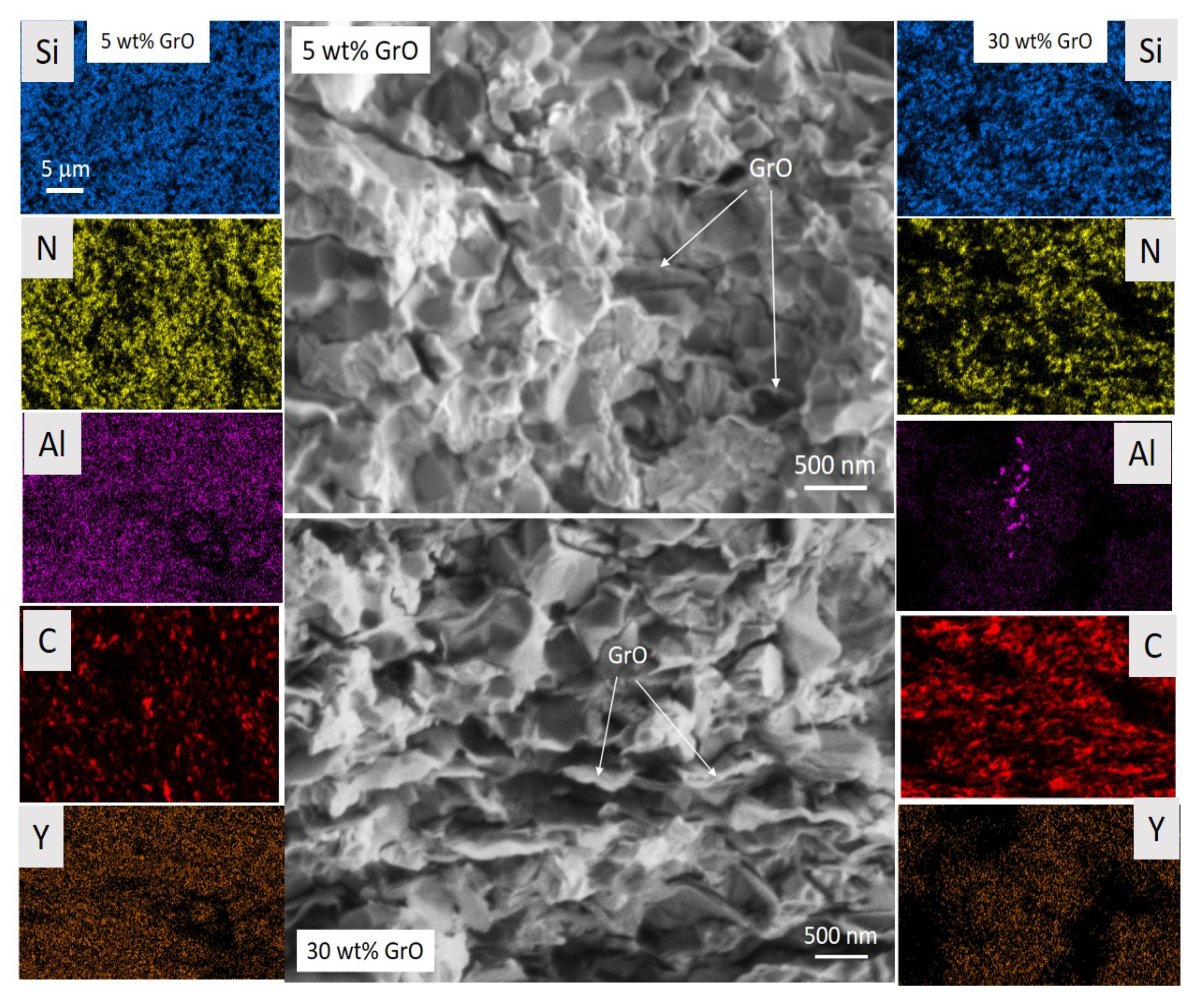

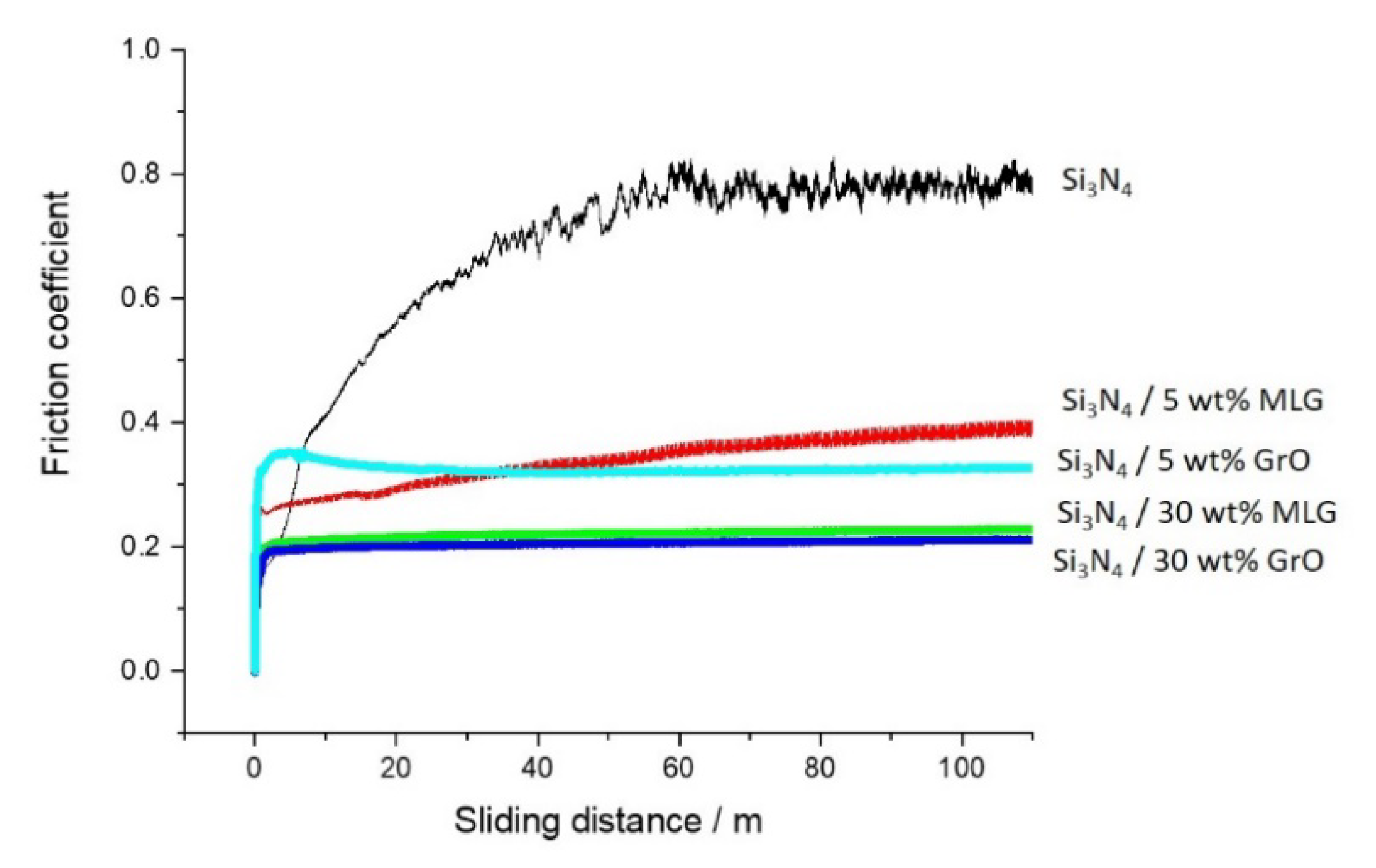
| Type of Graphene | Graphene Addition (wt%) | Specific Conductivity (S/m) |
|---|---|---|
| - | 0 | 9.69 × 10−6 |
| MLG | 5 | 8.25 × 10−3 |
| 30 | 8.35 | |
| GrO | 5 | 0.46 |
| 30 | 3.07 |
© 2020 by the authors. Licensee MDPI, Basel, Switzerland. This article is an open access article distributed under the terms and conditions of the Creative Commons Attribution (CC BY) license (http://creativecommons.org/licenses/by/4.0/).
Share and Cite
Balazsi, K.; Furkó, M.; Klimczyk, P.; Balázsi, C. Influence of Graphene and Graphene Oxide on Properties of Spark Plasma Sintered Si3N4 Ceramic Matrix. Ceramics 2020, 3, 40-50. https://doi.org/10.3390/ceramics3010005
Balazsi K, Furkó M, Klimczyk P, Balázsi C. Influence of Graphene and Graphene Oxide on Properties of Spark Plasma Sintered Si3N4 Ceramic Matrix. Ceramics. 2020; 3(1):40-50. https://doi.org/10.3390/ceramics3010005
Chicago/Turabian StyleBalazsi, Katalin, Mónika Furkó, Piotr Klimczyk, and Csaba Balázsi. 2020. "Influence of Graphene and Graphene Oxide on Properties of Spark Plasma Sintered Si3N4 Ceramic Matrix" Ceramics 3, no. 1: 40-50. https://doi.org/10.3390/ceramics3010005
APA StyleBalazsi, K., Furkó, M., Klimczyk, P., & Balázsi, C. (2020). Influence of Graphene and Graphene Oxide on Properties of Spark Plasma Sintered Si3N4 Ceramic Matrix. Ceramics, 3(1), 40-50. https://doi.org/10.3390/ceramics3010005








